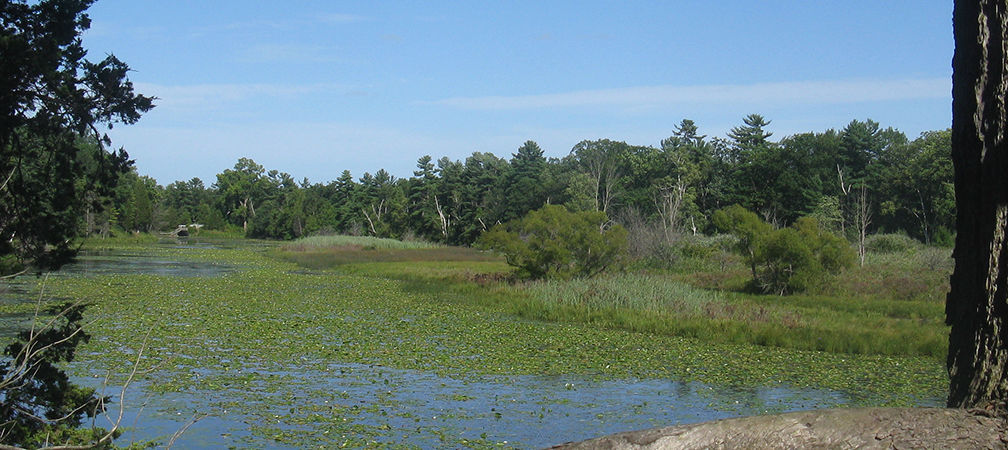Ontario Nature Blog
Receive email alerts about breaking conservation
and environmental news.
© Lora Denis
Cootes Paradise © girlguyed CC BY-NC 2.0
Although we are uncertain as to the origin of COVID-19, it is conceivable that transmission of a virus from a single bat may have resulted in a series of events that has brought human activity on Earth to a grinding halt. As the world is gripped with the COVID-19 pandemic, attention is drawn to the conditions that lead to zoonoses – diseases which are transmitted from other species to humans.
The prevalence of this type of disease appears to have increased over the last few decades. The United Nations Environment Programme (UNEP) indicates that 75 percent of all emerging infectious diseases in humans are zoonotic and that these diseases are closely linked to the health of ecosystems.
Zoonoses can be caused by direct transfer of pathogens from a non-human species to humans or by transmission through an intermediary. An example of the former is malaria, which is spread directly to humans through a parasite transmitted by mosquitoes when they bite. By contrast, the SARS epidemic may have originated from a virus in bats being transferred to another wildlife species (possibly wild civet cats) that were captured and sold in markets alongside other exotic and domestic species.

The risk of pathogen transmission has always existed, yet it is thought that the increased impact of human activity has led to a corresponding increase in the incidence of zoonotic diseases. For instance, wet markets – where meat, produce and live animals are sold –may create conditions for pathogen spillover, when overcrowded spaces put humans in contact with numerous animals that wouldn’t have come in contact with each other in their natural habitat. The conditions in which these animals are kept may also make them susceptible to get sick.
“The stress of captivity weakens the animals’ immune system and creates an environment where mutating viruses can slip from one species to another” says Jason Beaubien, Global Health and Development Correspondent. And even though the novel coronavirus has raised concerns over bat populations (with some people asking to destroy nesting habitats) scientists suggest that culling wildlife as an attempt to control the pandemic would actually increase the risk of infectious diseases, because it is not animals themselves that cause the problem but our interactions with the natural world.
Habitat fragmentation and degradation of areas previously rich in biodiversity, have resulted in increased contact with species that remain capable of surviving in the altered habitat. The introduction of livestock herds in the buffer zones between human settlements and remaining ecosystems has also caused problems. According to a 2016 report by UNEP, “livestock often serve as an epidemiological bridge between wildlife and human infections. This is especially the case for intensively reared livestock which are often genetically similar within a herd or flock and therefore lack the genetic diversity that provides resilience.”
In a richly diverse ecosystem, potential disease-causing pathogens are spread out over many species, some of which are asymptomatic and poor disease spreaders. This produces a lower level of pathogen prevalence across the ecosystem. When biodiversity is degraded, disease spread to humans can increase from animals such as rodents which are better adapted to survive and become relatively more dominant.
A North American example of a zoonotic disease enhanced by biodiversity loss is West Nile disease. As bird diversity decreases, the incidence of West Nile virus in humans increases. Lyme disease is another example. Forest fragmentation has led to an increased risk of Lyme disease in humans because of reduced biodiversity and the associated increase in the density of white-footed mice, an efficient host for the blacklegged ticks that spread Lyme disease.
Reducing the risk of disease transmission from animals to humans depends on reducing human activities that harm the species with which we share the planet. However, it is important to acknowledge that some of these activities support many livelihoods (some of which are in the poorest regions) so we must consider alternative sources of income. Scientists are advocating for a “One Health” global approach, one in which we recognize the health of people and biodiversity are interconnected. Ultimately, respect toward planet Earth and the species that inhabit it will go a long way toward protecting us from zoonotic disease.

Proposed 413 Route, Old School Road with farm and escarpment view © Noah Cole
Thank you, Ron, for the very timely and informative blog. I hope it will be read by many, and that they will spread the message about the need for increased biodiversity. This Covid-19 pandemic is surely a wake-up call for people to understand that enhanced biodiversity is essential for good health and resilience to disease.